What Higher Interest Rates Mean for DeFi

The decentralized finance space has enjoyed massive growth over the past several years. Investors have happily poured capital into the space to take advantage of yields that were far better than anything seen in traditional finance.
Like most risk assets, crypto performs best when interest rates are low, and capital is plentiful. The historically low traditional interest rates and money printing from the Federal Reserve has benefited crypto in a number of ways.
However, as we head towards 2023, that narrative is changing. We’ll soon see just how sticky DeFi is to investors who now have other acceptable alternatives for generating somewhat safe and stable yields.
With the Federal Reserve enacting a fourth consecutive 0.75% interest rate hike last week, interest rates are at their highest levels since 2008, a time when there was no crypto and no DeFi, and rates are expected to continue rising well into next year.
With traditional lending becoming expensive, capital will be harder to come by. More importantly, with the yield on U.S. Treasuries rising above 4%, investors now have a safe and stable alternative to DeFi for generating solid yields.
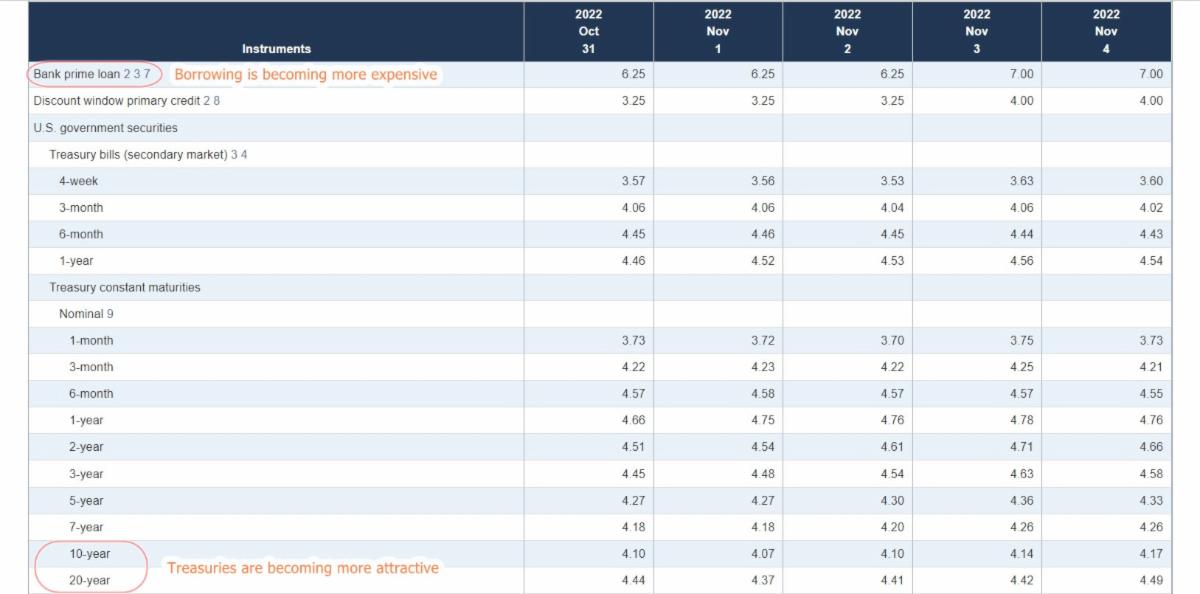
We’ve seen DeFi lending rates moderate as the crypto space becomes more mature and stable. While lower rates aren’t ideal, more stability is welcome in the space. However, these lower rates aren’t as competitive with U.S. Treasuries any longer, and DeFi lending is considered riskier when compared with the safety of U.S. Treasuries.
Fortunately, crypto markets have remained somewhat calm during this rate hike cycle, though we’ve seen a pullback over the past week following the latest Fed rate hike.
While the interest rate paid on bank savings accounts remains pitifully low, rates for major crypto lending players are lower on average than the rates available from Treasuries. Even three-month T-bills are yielding better than Ethereum and other crypto assets.
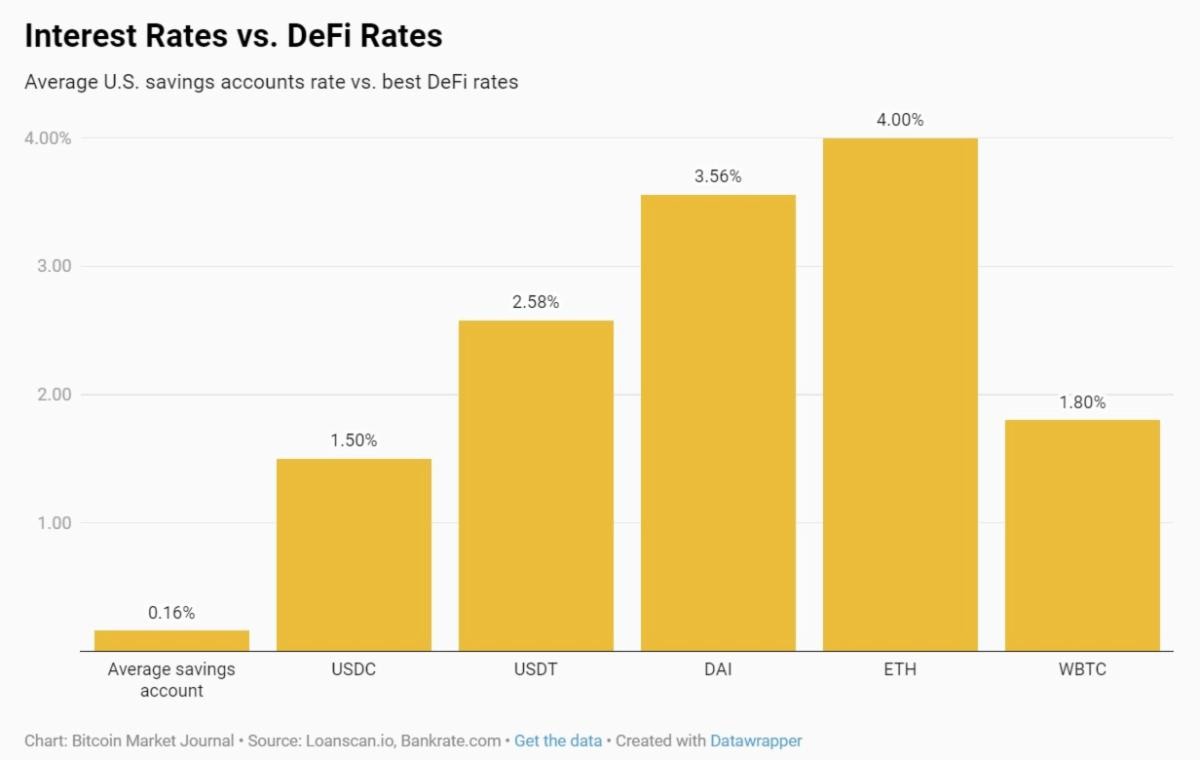
Even Higher Interest Rates are Coming
Fed chairman Jerome Powell has been clear in signaling further interest rate hikes in the coming months. The Fed is increasing rates to tamp down inflation in the U.S., which has been at its highest levels since 1980.
The FedWatch tool from the Chicago Mercantile Exchange calculates the expectations of market participants for future Federal Funds rates. Often, it can be fairly accurate on a short-term basis:
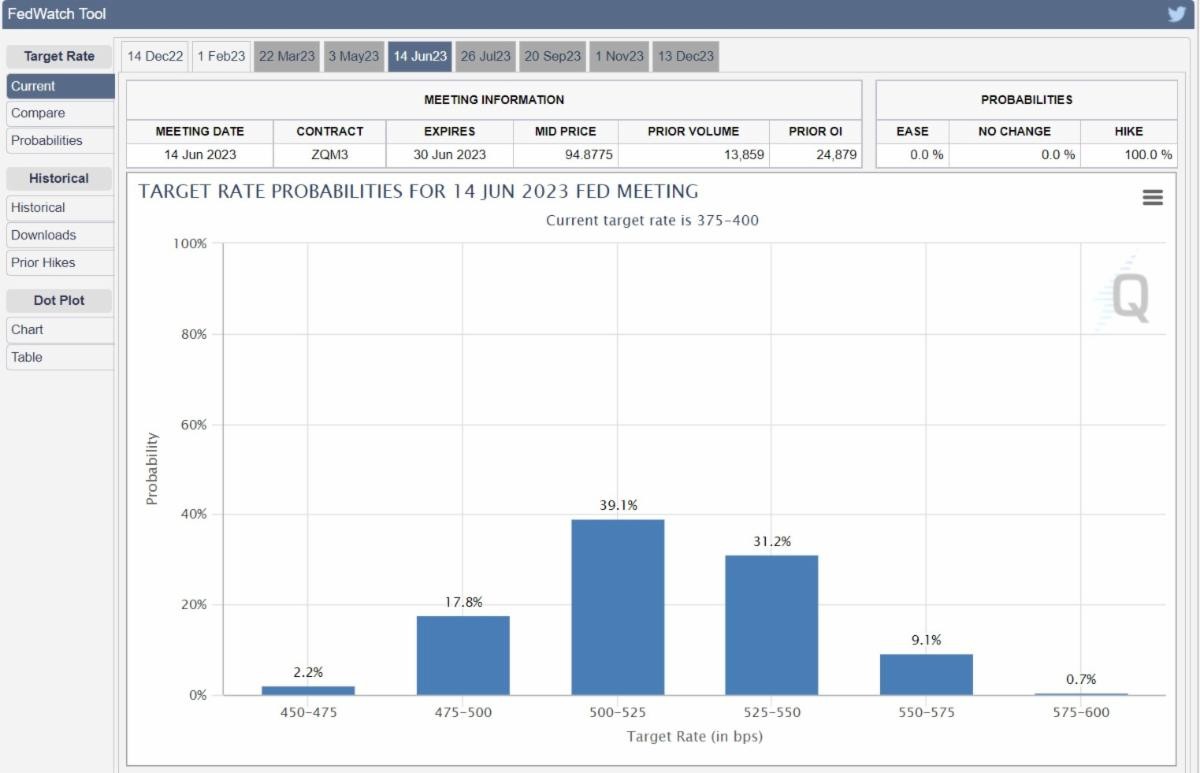
As you can see, the market believes there’s at least a small chance for interest rates to increase to 6% by June 2023.
Note this is the Federal Funds interest rate or the rate the Fed uses when lending to banks. Real rates (i.e., bank loans and Treasury yields) will be somewhat higher than the Federal Funds rate.
If the Fed Funds hits 6%, it’s likely short-term T-bills will be yielding 6.25% or slightly more. How will that impact DeFi markets?
What High Interest Rates Mean for Decentralized Finance
Common sense tells us investors should seek the highest yields with the lowest risk.
Considering that U.S. Treasuries are considered one of the most risk-free investments available, it’s surprising to see DeFi platforms attracting any sort of capital. However, data shows all DeFi platforms are still holding Total Value Locked (TVL) of $52.3 billion, though a close inspection shows us this number has been falling.
The biggest drop came after the first large interest rate increase in May 2022. While things have leveled off somewhat, we can see that over the past seven days since the latest Fed rate hike, most of the top ten DeFi platforms have seen their TVL drop further. As traditional and DeFi rates diverge further, we should expect to see further capital fleeing from the DeFi marketplace.
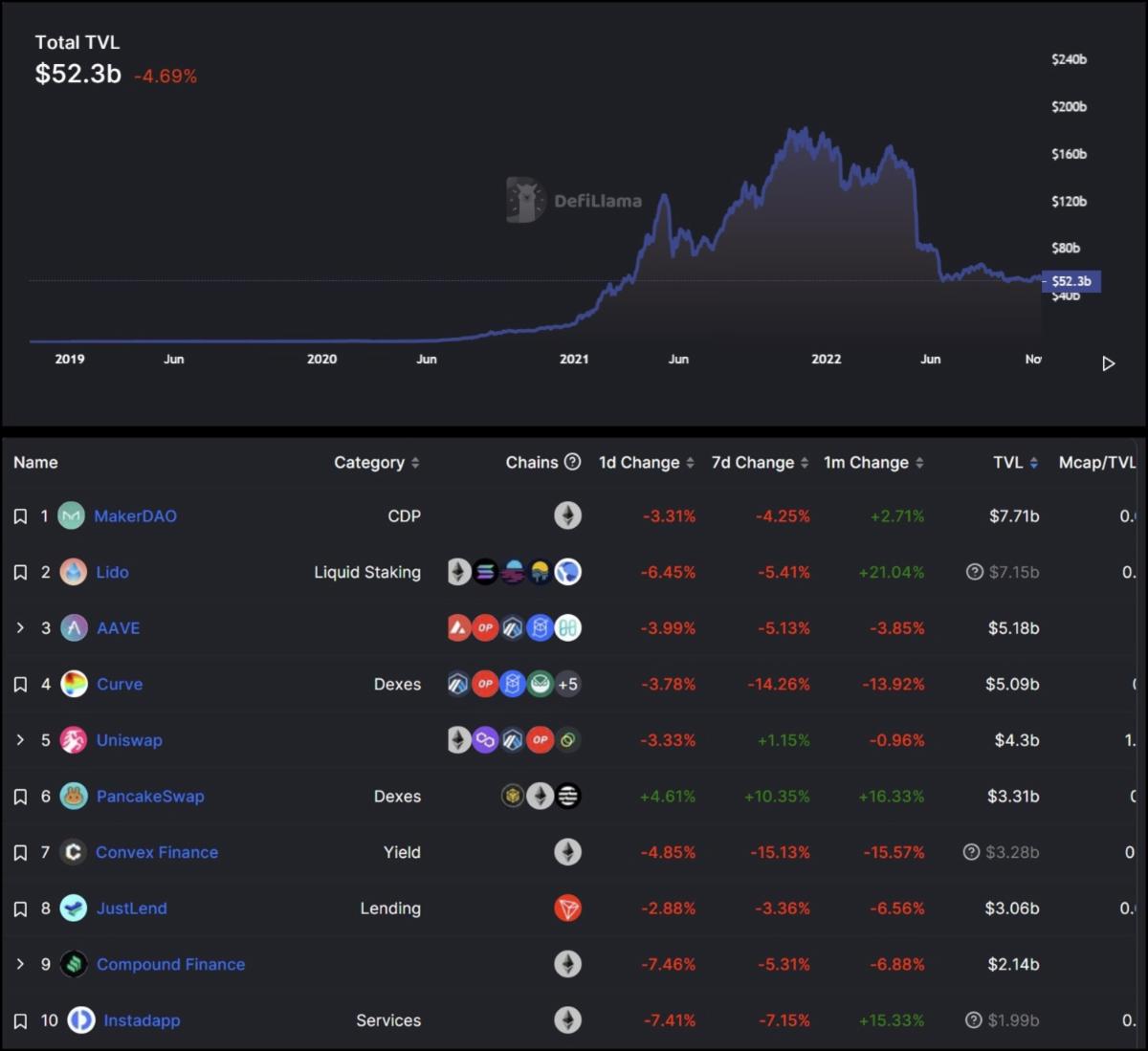
It’s also worth noting the drop in TVL for DeFi platforms is causing a drop in circulating stablecoins, which are often used in DeFi lending platforms.
For example, the circulating supply of USDC has dropped from $53.9 billion in June 2022 to $42.5 billion at the start of November 2022. That could be due to rising interest rates as the yield on USDC at the top three DeFi platforms is well under 2%.
DeFi Versus TradFi
It’s been suggested that one saving factor for DeFi is the difficulty in moving funds out of DeFi platforms and back into traditional finance. The question now is whether continued interest rate increases will drain capital from stablecoins to the point where it has a meaningful impact on the DeFi ecosystem.
Even if we were to see an impact, it likely wouldn’t mean the death of DeFi. It would simply mean rates will need to adjust to the macro environment and less borrowing will be seen in the DeFi space. However, the underlying value of DeFi will remain regardless of traditional and DeFi rates.
Theoretically, borrowing rates on lending platforms will naturally rise as the circulating supply of stablecoins drops. This increased rate is a supply/demand scenario that reflects the lowered availability of dollar-pegged assets. Also, as the friction between traditional and decentralized finance decreases, rates may come together as traders are more able to easily arbitrage rate differentials between traditional and DeFi products.
Potential Trends
While stablecoin lending could drop off until the friction between traditional and decentralized markets abates, we may see a shift in lending towards Ethereum.
The shift to proof of stake has already seen ETH lending rates increase as the tokenomics of the chain switch to a more deflationary stance and demand for ETH increases.
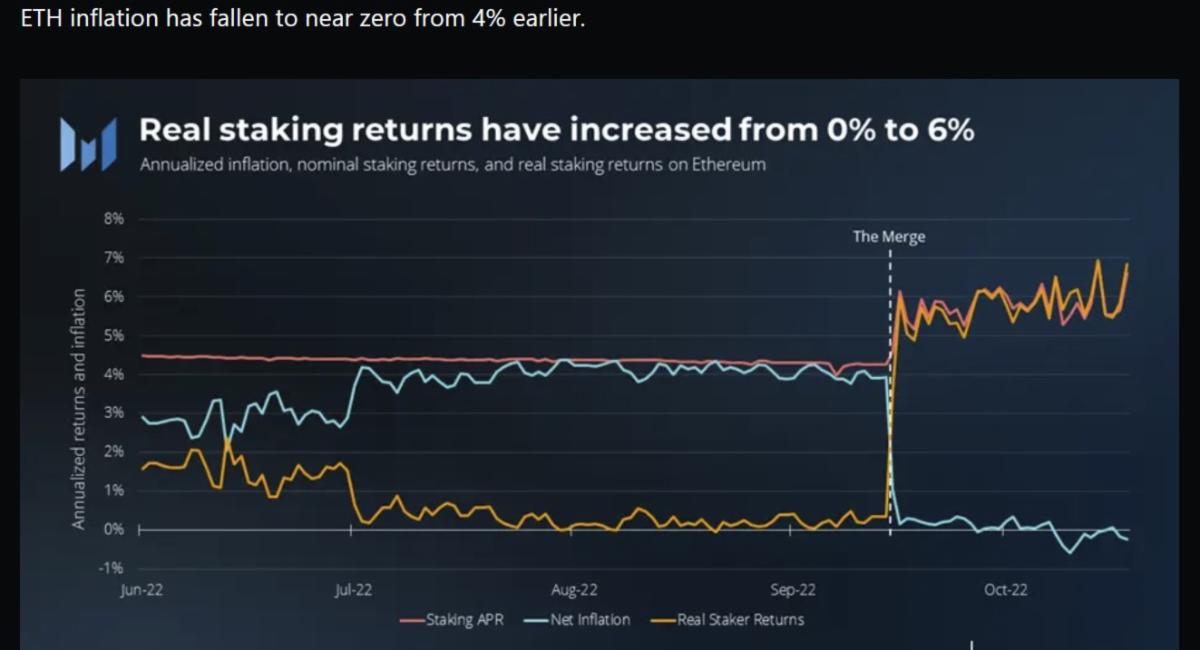
Another potential trend that could increase interest in the DeFi space, despite lower lending rates, is fixed rate lending.
Until now, DeFi has only seen variable rate protocols due to their being easier to implement. The addition of fixed rate protocols could attract more capital to DeFi, as businesses typically look to lock in fixed rates to help them reliably forecast expenses and cash flow.
The addition of fixed rate protocols would theoretically help DeFi connect more with traditional finance, thus lowering the friction between the two systems.
Investor Takeaway
As traditional rates continue to rise, we expect DeFi to see less institutional interest.
The eye-popping rates that were seen in the early days of DeFi lending are largely gone, and where they remain, they’re met with lots of skepticism.
Higher traditional yields will make it increasingly difficult for DeFi to attract institutional money as these large funds and investors are now able to get better, nearly risk-free rates in highly liquid bond markets.
Still, pure yields aren’t the real attraction of DeFi. Rather, they are the innovations promised by DeFi that will see the arena’s continued growth.
There’s obviously a market for decentralized finance products, and we’re still early in the process of discovering how DeFi can best be used. It’s not necessarily the high yields of the past that will increase interest in DeFi, but rather the innovation and freedoms promised by blockchain technologies.






 Bitcoin
Bitcoin  Ethereum
Ethereum  Tether
Tether  USDC
USDC  TRON
TRON  Dogecoin
Dogecoin  Cardano
Cardano  Bitcoin Cash
Bitcoin Cash  Chainlink
Chainlink  LEO Token
LEO Token  Stellar
Stellar  Litecoin
Litecoin  Hedera
Hedera  Monero
Monero  Dai
Dai  OKB
OKB  Cronos
Cronos  Ethereum Classic
Ethereum Classic  Gate
Gate  Cosmos Hub
Cosmos Hub  VeChain
VeChain  Algorand
Algorand  KuCoin
KuCoin  Stacks
Stacks  Tether Gold
Tether Gold  Theta Network
Theta Network  Zcash
Zcash  IOTA
IOTA  Tezos
Tezos  TrueUSD
TrueUSD  NEO
NEO  Polygon
Polygon  Decred
Decred  Dash
Dash  Ravencoin
Ravencoin  Zilliqa
Zilliqa  Qtum
Qtum  Synthetix Network
Synthetix Network  0x Protocol
0x Protocol  Basic Attention
Basic Attention  Siacoin
Siacoin  Holo
Holo  DigiByte
DigiByte  Nano
Nano  Enjin Coin
Enjin Coin  Ontology
Ontology  Status
Status  Hive
Hive  Waves
Waves  Lisk
Lisk  Pax Dollar
Pax Dollar  Steem
Steem  BUSD
BUSD  Numeraire
Numeraire  NEM
NEM  Huobi
Huobi  OMG Network
OMG Network  Bitcoin Gold
Bitcoin Gold  Ren
Ren  HUSD
HUSD  Augur
Augur